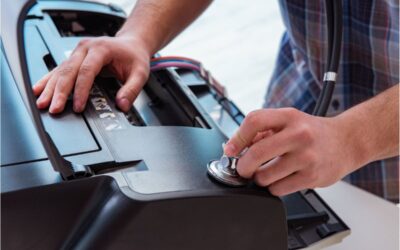Paper jams are the number one reason businesses call for printer and copier service. Even with proper setup and regular maintenance, paper jams can still occur, disrupting workflow and causing frustration.
Print jobs can fail for various reasons, but few issues are as aggravating—or as common—as paper jams. At BDS, we understand that your office printers and copiers play a critical role in keeping your business running smoothly. A jammed printer can slow down operations, delay important documents, and even lead to costly downtime.
In this guide, we’ll explore the most frequent causes of paper jams, from misaligned paper trays to worn-out rollers. More importantly, we’ll provide essential tips to help you prevent jams before they happen, ensuring your devices run efficiently and reliably. Whether you’re using a desktop printer or a high-volume multifunction copier, proactive maintenance is key to minimizing disruptions and maximizing productivity.
Why do printer paper jams occur?
Paper jams occur when paper or other printed materials become stuck in a printer and cannot be removed. Multifunction printers have several access doors to locate and clear jams, sometimes complicating things.
How to prevent printer jams
There are several ways to avoid paper jams. Taking measures to avert problems can lessen the workload of IT personnel and minimize frustrations. This is why it is essential to take steps to ensure the smooth functioning of your printing system.
Three preventable causes of paper jams:
Multifunction device for paper handling
A copier’s performance can be significantly improved by using proper paper handling. Always read the manufacturer’s manual to find out how much paper your multifunction device can handle. Too much paper in the tray can cause it to stick.
This causes the feeder to pull multiple sheets through. This results in a paper jam. Make sure you consider the volume of paper you will be printing each month when looking for an MFP machine.
Never load the incorrect paper for your device
Using the right paper weight to ensure the highest performance is also critical. You will likely have a paper jam if you use paper heavier than your copier’s maximum specifications.
Depending on the weight and size of the paper you’re loading, always check your printer’s paper settings. You should never load paper of different weights at the same time. If you are unsure of what type of quality paper your device takes, check your manufacturer’s manual.
Where do you store your paper?
Storing paper in a cool, dry place, away from direct sunlight, heat, and humidity, is imperative. Your printing equipment’s performance can be negatively impacted by how paper is stored.
Paper absorbs moisture from the air when it is removed from its packaging. The paper expands when it is moist. As a result, the paper’s size, flatness, and strength are altered, causing printer paper jams.
How to fix a paper jam
- Step one:
We recommend turning the printer off before searching for jammed paper. - Step two:
Next, locate the jammed paper. Do not pull on the paper because you will most likely tear it while pulling. If the rollers have already begun moving the paper through, continue pushing the document through. Do not attempt to go against the main direction of the paper. - Step three:
When you’ve removed the jammed paper, close all the access doors and turn the printer back on. The printer will likely need to recalibrate upon restart.
No paper is jammed, but I am still getting an error message
Too many print jobs in the queue
There are too many people trying to print at once. The printing command will not work if it does not respond. Don’t repeat the command. Occasionally, multiple printing commands can lead to a paper jam.
Paper pickup rollers accumulate dust
Dust can clog rollers and jam machines. Cleaning the rollers monthly can help prevent printer jams.
Software or hardware problems are affecting the printer
Make sure your printer software is up to date. Occasionally, the printer may signal a “paper jam” when none exists. If the message keeps appearing, restart the printer.
There are times when parts need to be replaced because of unexpected problems. Professionals should handle this.
Is your printer in need of repair or a print management expert?
Our team would love to help! The BDS team is ready to support your business’s print and workflow needs with over 40 years of print management experience.
Looking to stay current on industry news, insights and products? Follow us on our Facebook, LinkedIn, and YouTube pages, and regularly check our blog for new content!






